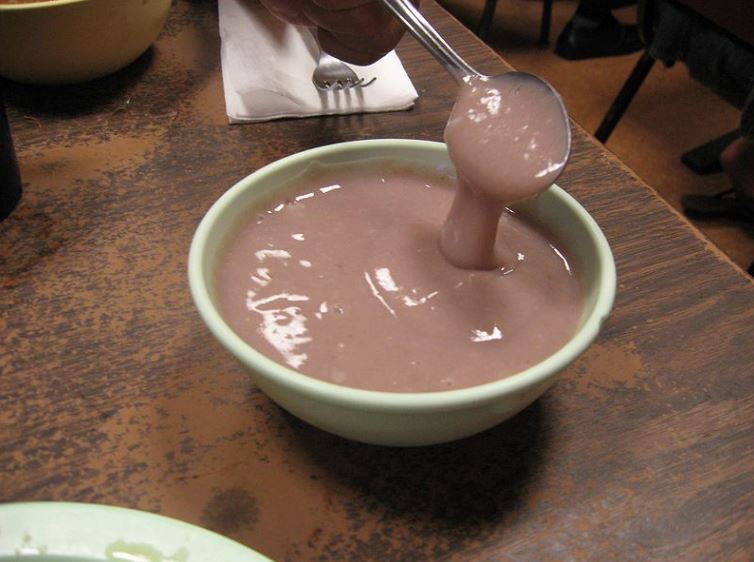Poi, also known as popoi, is a traditional Polynesian staple meal made from starchy vegetables, most commonly breadfruit, taro, or plantains. One of the many distinguishing cultural traits of native Hawaii is the importance of poi in Hawaiian history and religion; the usage of poi as a main element in food is a testament to this. Poi is a recipe for maintaining its unique past and reviving its island culture.
According to folklore, the first Hawaiian, Haloa, was created from the ground and the sky and came to the Hawaiians as the kalo, or taro plant. After creating the beautiful Hawaiian islands, the stars, and the sky, the earth and the heavens gave birth to Haloa. Because they believed he was stillborn and were mourning the loss of their child, they wrapped him and buried him in the earth. Then Haloa grew, bursting into beautiful heart-shaped leaves and stalks.
The first Hawaiian and the ancestor of all islanders, he was regarded as such at the time. There are still many connections between contemporary Hawaiian cuisine and the traditional Hawaiian religion. As a means to honor Haloa and keep his spirit alive, Hawaiians prepare taro into poi and eat it with every meal. Haloa is kept active in their lives as a result of this.
Poi is traditionally made by mashing cooked starch with a carved pestle made of basalt, calcite, coral, or wood on a wooden pounding board. Utilizing contemporary techniques, enormous volumes of food are produced for retail distribution. To attain the required consistency, which can range from highly viscous to liquid, water is added to the starch during mashing and once more just before eating.
Poi can be consumed right away when it’s sweet and fresh, or it can be allowed to ferment and turn sour, acquiring a smell similar to plain yogurt. Poi that is fermenting can avoid forming a crust by adding a layer of water on top. Poi is said to have its origins in the Marquesas Islands, where it was developed after the first Polynesian explorers had settled there. Although food is mashed in other parts of the Pacific, the technique used is less sophisticated.
The boiled starch was pounded in a wooden bowl in Western Polynesia using a crude pounder made from the stem of a coconut leaf or a hard, unripe breadfruit that had several wooden pegs inserted into it. Poi’s growth in the Marquesas paralleled the rise of basalt pounders, which quickly expanded throughout Eastern Polynesia, with the exception of New Zealand and Easter Island. When a bowl of poi was revealed for consumption at the family dinner table, Hawaiians believed that Hloa, the mythical progenitor of the Hawaiian people, was present since poi was such a significant and sacred part of daily Hawaiian life. As a result, all disputes between family members had to end right away.
Many people around the world eat taro, but only Hawaiians produce poi. The starchy, potato-like taro corm heart is customarily cooked for hours in an underground oven called an imu, along with other foods including pork, carrots, and sweet potatoes. When freshly made according to tradition, poi has a paste-like consistency, a delicate flavor, and a light purple hue that comes naturally from the taro corm.
It has a creamy, silky texture. Once the poi is prepared, the flavor changes noticeably. While the poi is initially sweet and palatable, it gradually loses sweetness and becomes sour over the course of the following day due to a natural fermentation involving the bacteria lactobacillus, yeast, and Geotrichum fungi. Consequently, some individuals find that fermented poi tastes better when it is combined with milk, sugar, or both. The rate of this fermentation process depends on the quantity of bacteria in the poi, but it can be slowed down by keeping the poi in a cool, dark place. Commercial poi that has been kept in a refrigerator needs to be prepared by squeezing it out of the bag into a bowl (often with the addition of water), then covering the exposed portion with a thin coating of water to prevent a crust from forming on top. New commercial poi preparations need to be refrigerated, but they taste sweeter and keep fresh longer.
Although it may be less appetizing, sour poi is still edible and is typically served with salted fish or Hawaiian lomi salmon on the side (as in the lyrics “my fish and poi”). Although the finished poi after defrosting or rehydrating tends to taste bland in comparison to the fresh product, sourness can be avoided by freezing or dehydrating fresh poi. Another application for sour poi is as a sour-tasting (buttermilk-like) component in baked goods like breads and buns. Taro is rich in complex carbohydrates, high in vitamin A, and low in fat.
Consuming poi has been linked to a number of health advantages, with some even comparing it to a miracle food since it helps people lose weight. Additionally, it is low in fat and protein, high in calcium, and has been linked to decreasing cholesterol.
Poi has been used specifically as a baby meal or a milk substitute for infants. It should be simple to digest. It is safe to eat for those with celiac disease or a gluten allergy because it doesn’t contain gluten. Depending on how many fingers are needed to scoop it up, this is referred to as “one-finger,” “two-finger,” or “three-finger” in Hawaii. The thicker the poi, the fewer fingers are needed to scoop up the proper amount.
Poi, a delectable recipe that can only be found in Hawaii and nowhere else in the world, has a fascinating past as a traditional Polynesian dish. It has evolved into a vital means of preserving the culture of the islanders’ occupants beyond only providing food. The community makes a lot of effort to uphold this tradition even if many of the former taro fields are now simply amazing locations for house building and other commercial constructions. The responsibility to uphold this custom and safeguard the recipe’s heritage has been placed on the locals. Poi makers and pounders claim that by conserving this food, they feel more connected to their forefathers and their heritage than ever before.

